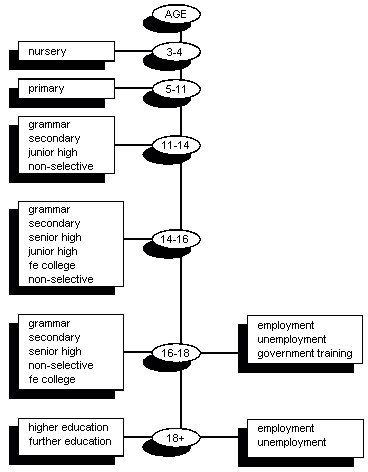  Centre for the Study of Conflict
Centre for the Study of ConflictSchool of History, Philosophy and Politics, Faculty of Humanities, University of Ulster
Centre Publications
[Background] [Staff] [Projects] [CENTRE PUBLICATIONS] [Other Information] [Contact Details] [Chronological Listing] [Alphabetical Listing] [Subject Listing]
Education and Religion in Northern Ireland by A M Gallagher Section 1: Opportunity and Option
Pre-school children Nursery education is not compulsory and provision is therefore limited. A report by the Northern Ireland Council for Educational Research (NICER) estimated that in 1985 nursery places were available for 13% of the three and four year olds in Northern Ireland (Wells and Burke, 1986; see also, Foote, 1980d). These places were available in 140 nursery schools and units which were concentrated in urban areas, particularly Belfast, Derry, Newtownabbey and Craigavon The majority (70%) of the nurseries had been opened between 1974 and 1980. Given the interest of the present study, it should be noted that 3 in every 4 of these nurseries were in the Controlled (Protestant) sector while the remainder were under Maintained (Catholic) management committees. The 1947 Education Act The structure of the education system in Northern Ireland has been largely shaped by the 1947 Education Act. Prior to the Act most people experienced only primary education, in the National Elementary Schools. A minority went onto secondary (grammar) schools. Entry to these schools was obtained by paying fees or gaining one of a limited number of scholarships, offered through competitive examinations by the Ministry of Education. The central feature of the 1947 Act was to provide secondary education for all pupils with the age of transfer from primary to secondary set at eleven years (Wilson, 1987). Following the 1944 Act in England and Wales, the Northern Ireland Act recognised three types of secondary school: secondary grammar, secondary technical and secondary intermediate. In fact the secondary technical schools failed to attract a significant number of pupils so that by the late 1950s and early 1960s a bilateral system of secondary education became established. The two school types in the bilateral system are normally referred to simply as grammar and secondary schools. The growth of secondary education After 1947 grammar schools continued to charge fees for pupils. Since the Act provided each child with the opportunity of a grammar school education, the Ministry of Education operated a selection procedure in order to identify those pupils most able for the academic curriculum of the grammar schools. Pupils selected under the procedure would have their fees paid for by the Ministry. The grammar schools were permitted to continue to take a limited number of fee-paying pupils. Unlike the rest of the United Kingdom, selection at eleven remains the predominant form of transfer from primary to secondary education in Northern Ireland. Between 1981 and 1985, for example, some 90% of pupils were involved with the selective procedure. The remaining 10% of pupils were involved with alternative transfer systems available in Northern Ireland (Wilson, 1986). In 1969 a system of delayed selection was established in the Craigavon area (McKernan, 1981, provides a detailed account of this initiative). In this system pupils automatically transfer at eleven to junior high schools. At age fourteen about a third of these pupils are selected for senior high schools, which offer a curriculum similar to that provided by grammar schools. The remaining two-thirds of pupils either remain in the junior high schools (in the 'Catholic' sector) or transfer to further education colleges (in the 'Protestant' sector). In addition, a small number of non-selective schools have operated in certain areas of Northern Ireland since the 1960s. Pupils automatically transfer to these non-selective schools at eleven and can remain there for the remainder of their secondary education careers. Beyond compulsory education The school leaving age in Northern Ireland is sixteen years. This is the age at which most pupils take their first public examinations (a minority sit some public examinations a year earlier, while others leave compulsory education without sitting any public examinations). Until 1988 the predominant types of examinations taken were GCE 0 Level and CSE; in addition, a minority of pupils, particularly in secondary schools, sat a variety of vocational examinations such as RSA, City and Guilds and Pitmans (see, for example, Gallagher, 1988). From 1988 onwards, GCE 0 level and CSE examinations were replaced by GCSE. After this stage, pupils with a set minimum level of qualifications can remain in school to work towards GCE A Level examinations. A Levels are usually, although not exclusively, taken in grammar or senior high schools: A Levels can be taken in some secondary schools and in further education colleges. Other pupils remain in school to repeat, or take extra, 0 Level or other examinations, while others enter further education to take vocational courses. On attaining the school-leaving age pupils may seek employment or enter Government training schemes. This latter provision has lowered the proportion of sixteen year old school-leavers who 'enter' unemployment, although this still occurs. Beyond secondary education The age of eighteen marks the end, for most pupils, of secondary education. Most of those still in secondary education at this stage take GCE A Levels. The options following this are to enter the labour market, further education and higher education. Within higher education there is a choice between university, polytechnic and teacher-training. Following the merger of the New University of Ulster and the Ulster Polytechnic in 1984 to form the University of Ulster, there is no longer any polytechnic provision in Northern Ireland This option is available if pupils are prepared to migrate to Great Britain. It should be noted that a proportion of Northern Ireland's eighteen year olds enter universities in Britain and the Republic of Ireland, even if the majority remain in Northern Ireland. Return to publication contents
Last Modified by Martin Melaugh : |
